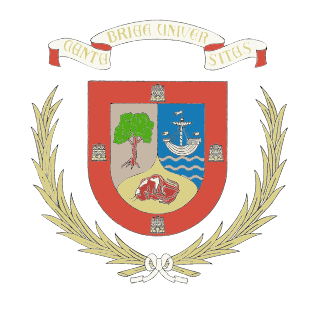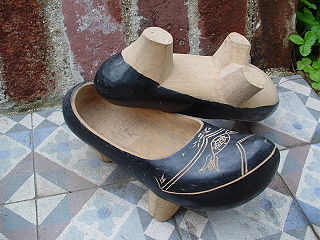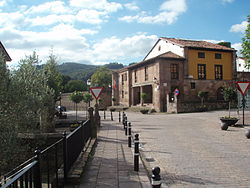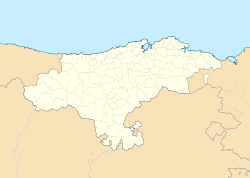
Cantabria is an autonomous community in northern Spain with Santander as its capital city. It is called a comunidad histórica, a historic community, in its current Statute of Autonomy. It is bordered on the east by the Basque autonomous community, on the south by Castile and León, on the west by the Principality of Asturias, and on the north by the Cantabrian Sea.

Santander is the capital of the autonomous community and historical region of Cantabria situated on the north coast of Spain. It is a port city located east of Gijón and west of Bilbao with a population of 172,000 (2017).

University of Cantabria (UC), is a public university located in Santander, Torrelavega and Comillas in Cantabria, Spain. It was founded in 1972 and is organized in 15 schools and colleges.
The Regionalist Party of Cantabria is the second oldest political party in the Spanish Autonomous Community of Cantabria. The PRC originated in the Association in Defense of the Interests of Cantabria (ADIC), founded on 14 May 1976, with the objective of promoting Cantabrian autonomy.

Torrelavega is a municipality and important industrial and commercial hub in the single province Autonomous Community of Cantabria, northern Spain.

The Cantabria autonomous football team is the regional football team for Cantabria, Spain. They are not affiliated with FIFA or UEFA and therefore are only allowed to play friendly matches.

Reinosa is a municipality in Cantabria, Spain. As of 2009, it has 10,307 inhabitants. The municipality, one of the smallest by land area in Cantabria, is notable for being one of the nearest towns to the headwaters of the Ebro River. It is surrounded by the municipality of Campoo de Enmedio and was created a city by King Alfonso XIII in 1927, being one of only three urban centres in Cantabria with that honour, the others being Santander and Torrelavega.
The Divisiones Regionales de Fútbol in the Cantabria, are organized by the Cantabrian Football Federation:

Campoo is a comarca of Cantabria (Spain) located in the High Ebro, with a surface little bigger than 1,000 km2, and including the municipalities of Hermandad de Campoo de Suso, Campoo de Enmedio, Campoo de Yuso, Valdeolea, Valdeprado del Río, Valderredible, Reinosa, Las Rozas de Valdearroyo, Santiurde de Reinosa, Pesquera, and San Miguel de Aguayo. Their inhabitants are called Campurrians . Its highest elevation is the Cuchillón peak, and the lowest is Pesquera, with the capital, Reinosa at 850 m.

Rayo Cantabria, formerly known as Real Racing Club de Santander "B" is the reserve team of Racing de Santander, a Spanish football team based in Santander, in the autonomous community of Cantabria.

Valle de Villaverde is a town and municipality in the autonomous community of Cantabria, Spain. It is surrounded by the Basque municipalities of Carranza, Arcentales, and Trucíos, but the town belongs to the administration of the government of Cantabria. Thus, it is an enclave of Biscay and an exclave of Cantabria.

Cave del Valle, locally also known as La Viejarrona, is located near El Cerro Village in the municipality of Rasines in Cantabria, northern Spain. The cave is the source of the Silencio River, a tributary of the Rio Ruahermosa, which in turn is a tributary of the Asón River. Notable for its prehistoric, but particularly for its speleologic significance as it is recognized as one of the longest cavities in the world. The site is very popular among cavers, who have explored a total of over 60 km (37.28 mi) so far.

The Cave of Altamira and Paleolithic Cave Art of Northern Spain is a grouping of 18 caves of northern Spain, which together represent the apogee of Upper Paleolithic cave art in Europe between 35,000 and 11,000 years ago. In 2008, they were collectively designated a World Heritage Site by UNESCO.
"Himno a la Montaña", or "Himno de Cantabria", is the official anthem of the Spanish autonomous community of Cantabria. It was composed in 1926 by Juan Guerrero Urresti at the behest of the then Provincial Council of Santander and subsequent arrangements by José del Río Sainz, in the region's official anthem.

A Cantabrian albarca is a rustic wooden shoe in one piece, which has been used particularly by the peasants of Cantabria, northern Spain. In the neighbouring province of Asturias madreñas are still being widely used in rural areas.
Cartes is a municipality located in the autonomous community of Cantabria, Spain.

Casa montañesa is a form of traditional construction of La Montaña in the communities of Cantabria, east of Asturias and northern Castile and León in northern Spain. It should not be confused with casona montañesa, which differs due to its grander style and incorporation of other features.

The 2023 Cantabrian regional election will be held on Sunday, 28 May 2023, to elect the 11th Parliament of the autonomous community of Cantabria. All 35 seats in the Parliament will be up for election. The election will be held simultaneously with regional elections in at least seven other autonomous communities and local elections all throughout Spain.

Unión Club Cartes is a Spanish football team located in Cartes, in the autonomous community of Cantabria. Founded in 1921 it currently plays in Tercera División RFEF – Group 3, holding home matches at Campo de Fútbol El Ansar with a capacity of 1,000 spectators.





















